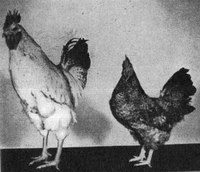Sex-linked recessive dwarfism, dw
Hutt studied in the 1940s a remarkable type of dwarfism caused by only one sex-linked recessive gene to which he assigned the symbol dw. [1]
This mutation reduces body weight in females by 26 to 32%, but the effect is still greater in homozygous males, by about 42–43%. Chicks are normal size. [12] [13] This is the best studied type of dwarfism in chickens. Sex-linked dwarfism in meat type breeds are first recognized by the shortening of the shanks than by the lowering body weight in the rearing period [14]
There are no signs of sex-linked dwarfism in the first weeks of age. Some individuals can be identified as dwarfs at 8–10 weeks of age, but classification is more precise when the chickens are five months old or more. At this point differences between normal and dwarf sibs is evident in all males and in 98% of the females. [1] These dwarfs reach sexual maturity and reproduce normally.
Normal females are always of genotype Dw/-, while dwarf females are always of genotype dw/-, because female is the heterogametic sex having only one Z chromosome. That is, females carrying a sex-linked gene of dwarfism are always pure and exhibit the trait. On the other hand, normal males may be either homozygous Dw/Dw or heterozygous Dw/dw, but dwarf males are always homozygous dw/dw.
Double dose of dwarf gene causes the dwarfism to be much more evident in males than in females. The above picture illustrates the comparative size of two full-sib roosters born the same day: Left: Normal sibling of genotype Dw/dw. Right: Dwarf sibling of genotype dw/dw.
Hormonal causes of dwarfism
Among the main factors involved in growth regulation, thyroid hormones tiroxine (T4) triiodothyronine (T3), growth hormone (GH), and its related growth factor, Insulin-like growth factor-I (IGF-I), were the most studied in dwarfs. [15]
Sex-linked dwarf chickens are characterized by low circulating levels of T3 and IGF-I in spite of normal or even increased levels of T4 and GH. The T3 deficiency is explained by a lower peripheral activity of T4 monodeiodination which could be related to an abnormal T4 uptake by the cell, particularly the hepatocyte. The low production of IGF-I could be related to a deficient GH receptor, as suggested by the decreased GH binding observed in the liver of dwarf birds. Both T3 and IGF-I synthesis may share common pathways since thyroidectomy also decreases IGF-I level while a GH injection stimulates the T4 to T3 monodeiodination in the normal embryo but not in the dwarf. Further studies are needed on the GH receptor and the T4 uptake in the hepatic cell to identify the common point where the dwarf gene could act. Ovulation rate and lipomobilisation are decreased in adult dwarfs but these findings are not yet easily related to the endocrinological changes observed during growth [16]
Administration of triiodothyronine (T3) in the diet, from day of hatch until 8 weeks of age, to sex-linked dwarf chickens stimulates growth but can not fully restore a normal growth rate. [17] [18]
Sex-linked dwarfism in chickens is a form of growth hormone resistance that resembles the Laron syndrome in humans, characterized by reductions in stature and plasma insulin-like growth factor-I (IGF-I) levels. [19]
Variants in chicken growth hormone receptor (GHR) gene lead to sex-linked dwarf chickens, but effects of different variants are distinct. [20]
Bantam dwarfism, dwB
Bantam dwarfism is a variety of dwarfism existing in many breeds of bantam chickens. Bantam chickens are also called miniatures. These birds are popular as pets, but Bantam hens are also renowned for hatching and brooding because they are very protective mothers and will attack anything that gets near their young.
The reciprocal crosses made between normal sized chickens with Bantams revealed that Bantams carry one or several sex-linked dominant genes that reduce body size. [21] [22] This mutation is present in Sebright Bantams and probably other bantams. This mutation is thought to be an allele at the Dw locus and to be different from the allele dw. [23]
In genetics, the common convention is that most dominant alleles are written as capital letters and recessive alleles as lower-case letters (see: Dominance (genetics)). In spite of this, literature refers to the gene of Bantam dwarfism with the lower-case symbol dwB.
MacDonald dwarfism, dwM
A second type of sex-linked recessive dwarfism was found in a sex-linked dwarf chicken population. This mutation is thought to be an allele or the Dw locus and to be different from the dw allele. This conclusion is based on the fact that males heterozygous for dwM/dw produce female offspring which fall into two populations with respect to shank length. [24] The evidence is inconclusive as to whether this allele is different or the same as the dwB allele.
Up to the present level of knowledge the dominance order of the alleles of locus Dw is: dwB > Dw > dw.
In other words, allele dwB for Bantam dwarfism is dominant over the normal allele Dw, and the last is dominant over the sex-linked recessive allele dw. The existence of a second recessive allele has not yet been confirmed.
